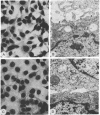Abstract
Fetal liver cells of DBA/2 mice were infected with the anemic strain of Friend leukemia virus (FLV-A), which has no spleen focus-forming virus (SFFV) activity. The infected cells were grown in medium with or without erythropoietin. Transformed lines were isolated only from the infected cultures that had been treated with erythropoietin at the time of their initiation. The properties of three permanent cell lines in serial passage for over 2 years are described. Each has an aneuploid karyotype. Only the immature hematopoietic cells of the first line have metacentric chromosomes. They grow in suspension, as do the erythroleukemic lines derived from leukemic spleens of FLV-infected mice, and clone on agar. They produce tumors resembling reticulum cell sarcomas upon subcutaneous inoculation into syngeneic hosts. Stimulation of differentiation induced after treatment with dimethyl sulfoxide identifies the cells of the first line as being erythroid in origin. The two other lines are adherent and epithelioid in appearance. These lines may have originated from the nonhematopoietic cells present in fetal liver. No tumors were produced after the subcutaneous inoculation of 10(6) cells. All three lines synthesize virus. The virus is attenuated for leukemogenicity and has no SFFV activity. The transforming event appears to be specific, because fetal liver cells from C57BL/6 mice, which are resistant to the induction of leukemia by FLV, were not affected by the virus. Malignant transformation of erythroid cells by FLV-A in vitro confirms the in vivo findings that SFFV may not be a necessary prerequisite for the induction of erythroleukemia in susceptible hosts.
Full text
PDF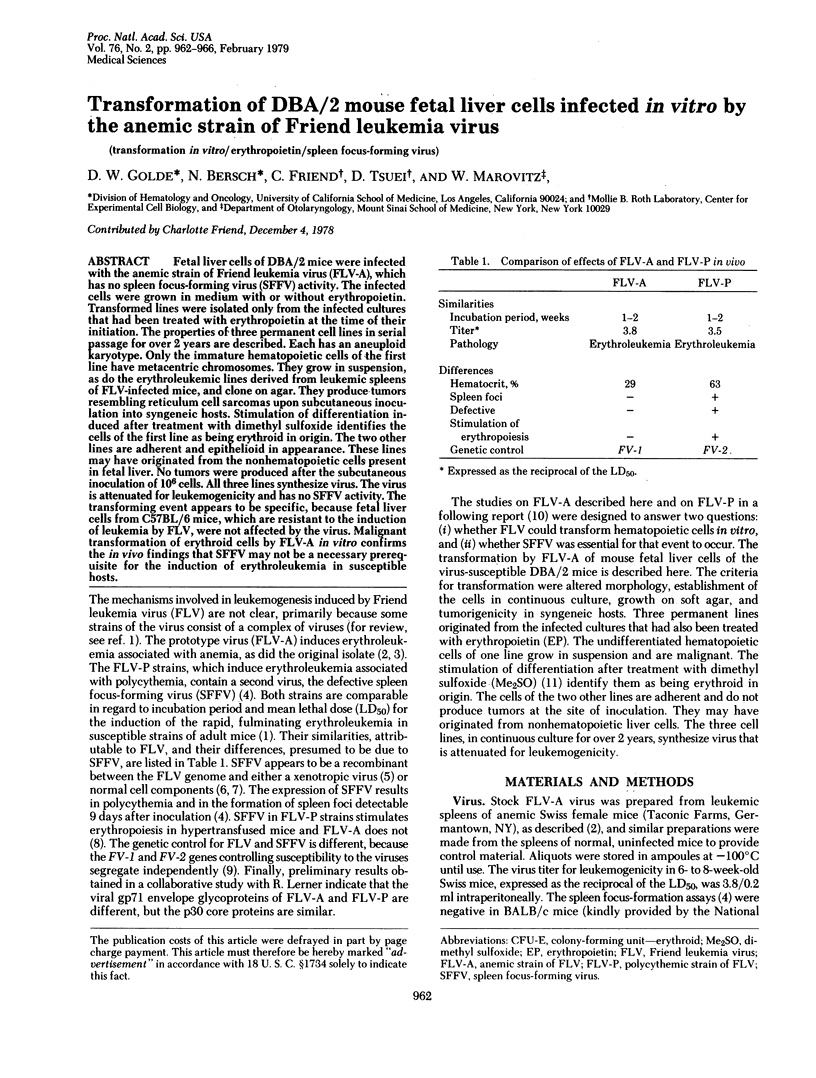
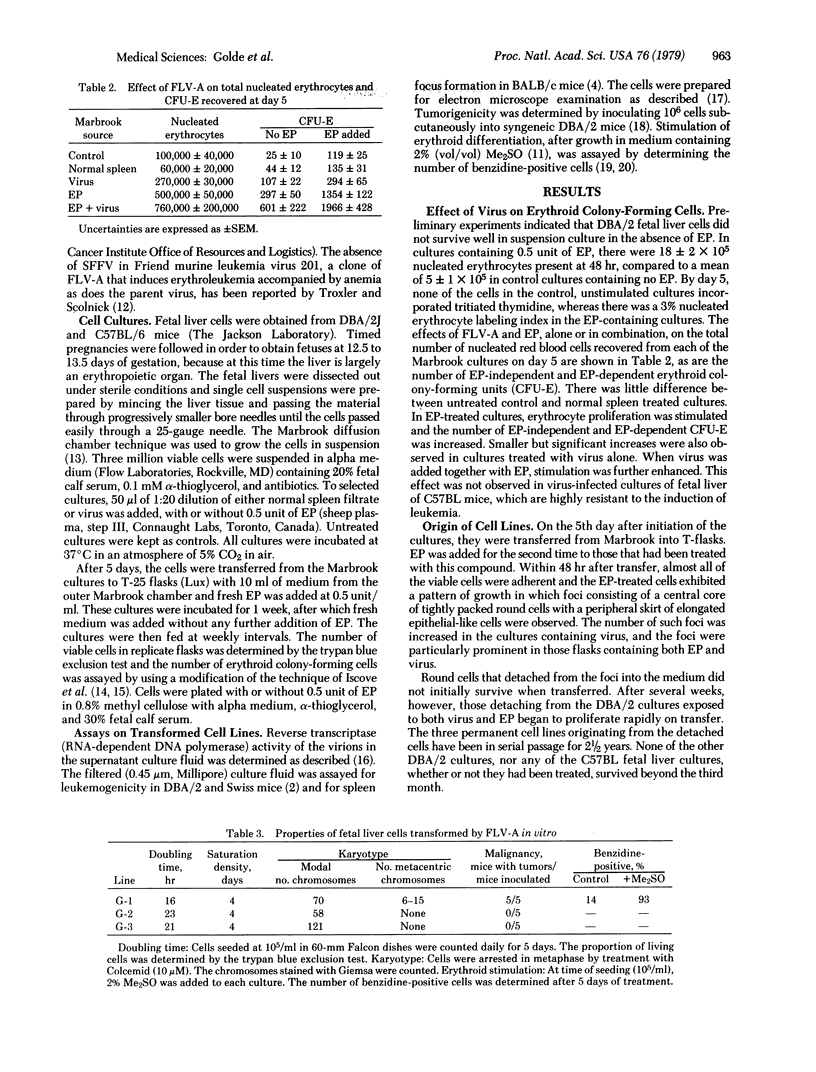
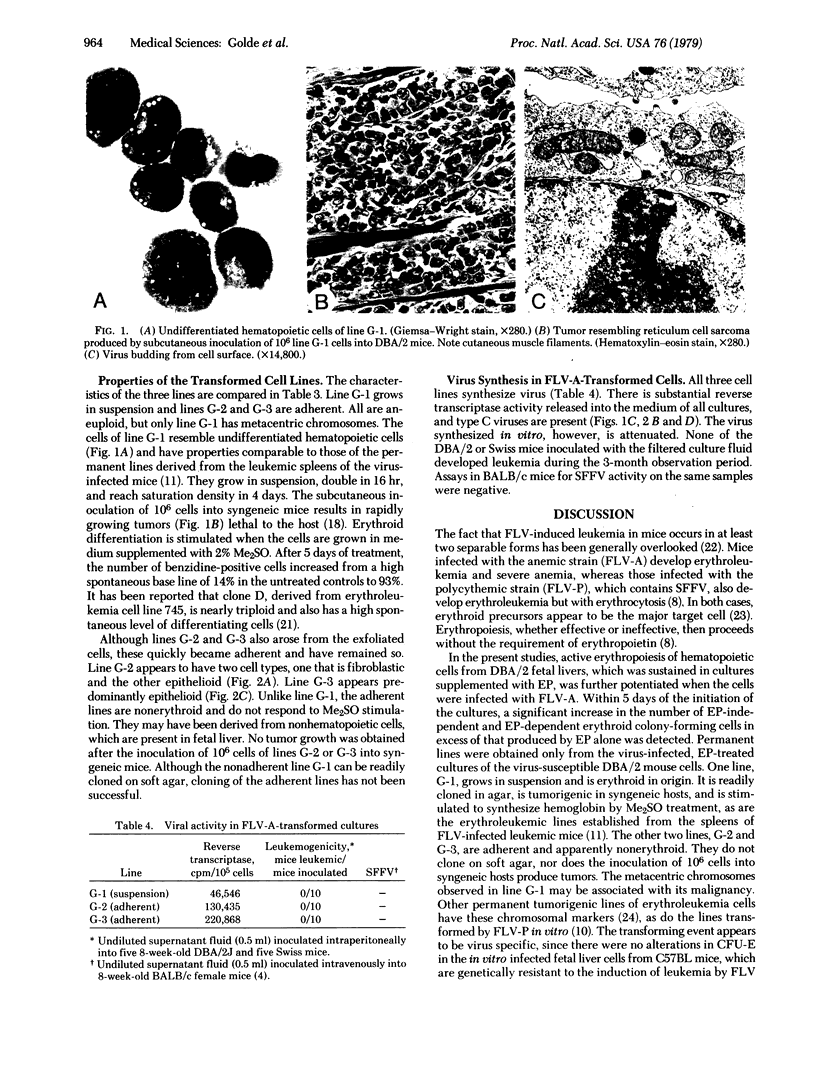
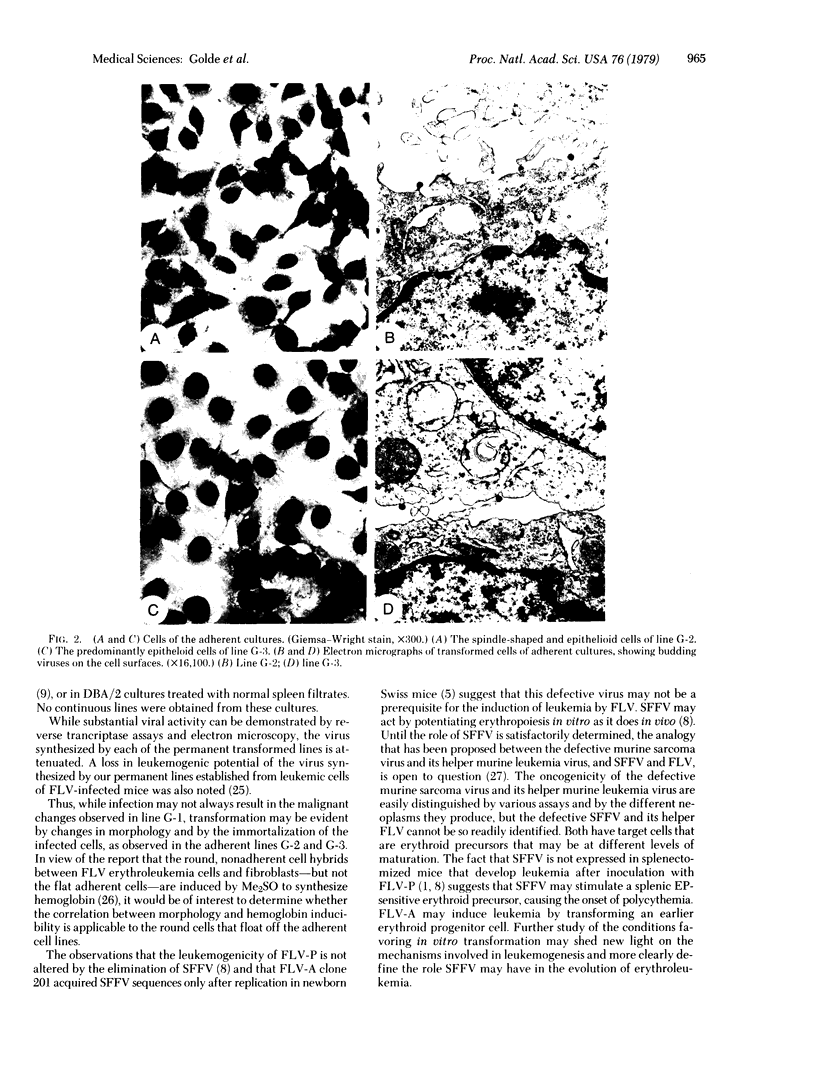
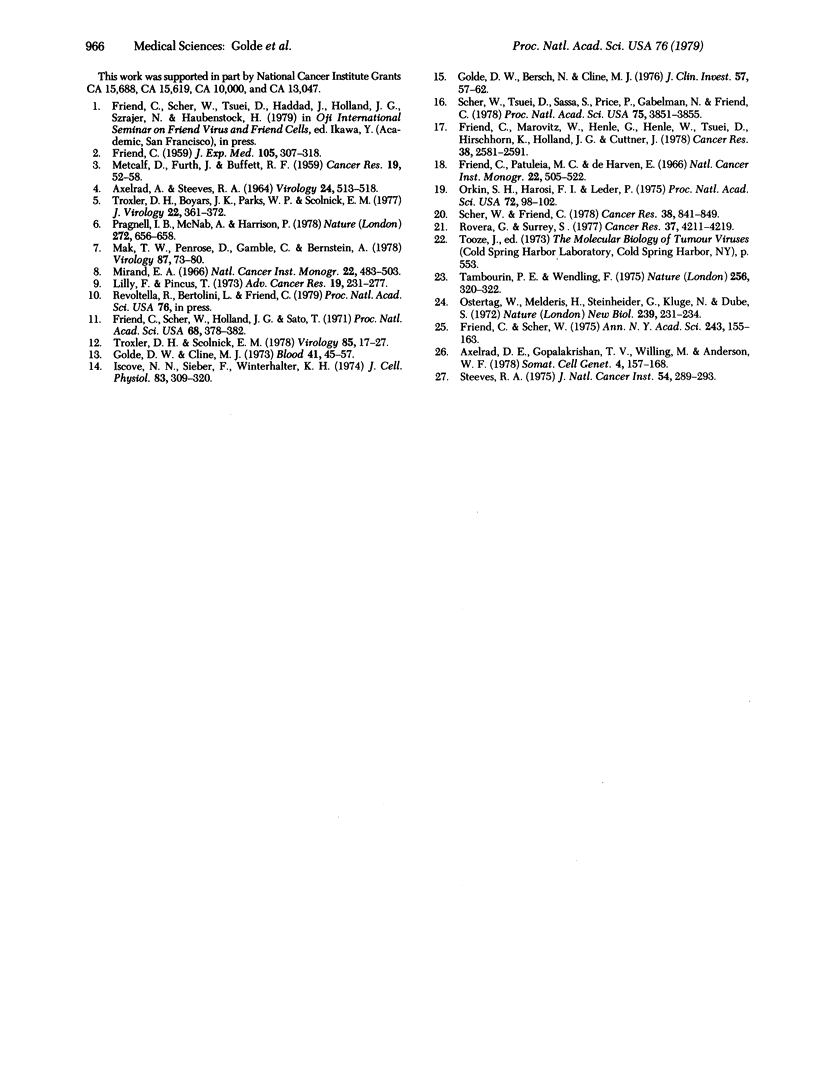
Images in this article
Selected References
These references are in PubMed. This may not be the complete list of references from this article.
- AXELRAD A. A., STEEVES R. A. ASSAY FOR FRIEND LEUKEMIA VIRUS: RAPID QUANTITATIVE METHOD BASED ON ENUMERATION OF MACROSCOPIC SPLEEN FOCI IN MICE. Virology. 1964 Nov;24:513–518. doi: 10.1016/0042-6822(64)90199-0. [DOI] [PubMed] [Google Scholar]
- Axelrod D. E., Gopalakrishnan T. V., Willing M., Anderson W. F. Maintenance of hemoglobin inducibility in somatic cell hybrids of tetraploid (2S) mouse erythroleukemia cells with mouse or human fibroblasts. Somatic Cell Genet. 1978 Mar;4(2):157–168. doi: 10.1007/BF01538981. [DOI] [PubMed] [Google Scholar]
- FRIEND C. Cell-free transmission in adult Swiss mice of a disease having the character of a leukemia. J Exp Med. 1957 Apr 1;105(4):307–318. doi: 10.1084/jem.105.4.307. [DOI] [PMC free article] [PubMed] [Google Scholar]
- Friend C., Marovitz W., Henie G., Henie W., Tsuei D., Hirschhorn K., Holland J. G., Cuttner J. Observations on cell lines derived from a patient with Hodgkin's disease. Cancer Res. 1978 Aug;38(8):2581–2591. [PubMed] [Google Scholar]
- Friend C., Patuleia M. C., De Harven E. Erythrocytic maturation in vitro of murine (Friend) virus-induced leukemic cells. Natl Cancer Inst Monogr. 1966 Sep;22:505–522. [PubMed] [Google Scholar]
- Friend C., Scher W., Holland J. G., Sato T. Hemoglobin synthesis in murine virus-induced leukemic cells in vitro: stimulation of erythroid differentiation by dimethyl sulfoxide. Proc Natl Acad Sci U S A. 1971 Feb;68(2):378–382. doi: 10.1073/pnas.68.2.378. [DOI] [PMC free article] [PubMed] [Google Scholar]
- Friend C., Scher W. Stimulation by dimethyl sulfoxide of erythroid differentiation and hemoglobin synthesis in murine virus-induced leukemic cells. Ann N Y Acad Sci. 1975 Jan 27;243:155–163. doi: 10.1111/j.1749-6632.1975.tb25354.x. [DOI] [PubMed] [Google Scholar]
- Golde D. W., Bersch N., Cline M. J. Potentiation of erythropoiesis in vitro by dexamethasone. J Clin Invest. 1976 Jan;57(1):57–62. doi: 10.1172/JCI108269. [DOI] [PMC free article] [PubMed] [Google Scholar]
- Golde D. W., Cline M. J. Growth of human bone marrow in liquid culture. Blood. 1973 Jan;41(1):45–57. [PubMed] [Google Scholar]
- Iscove N. N., Sieber F., Winterhalter K. H. Erythroid colony formation in cultures of mouse and human bone marrow: analysis of the requirement for erythropoietin by gel filtration and affinity chromatography on agarose-concanavalin A. J Cell Physiol. 1974 Apr;83(2):309–320. doi: 10.1002/jcp.1040830218. [DOI] [PubMed] [Google Scholar]
- METCALF D., FURTH J., BUFFETT R. F. Pathogenesis of mouse leukemia caused by Friend virus. Cancer Res. 1959 Jan;19(1):52–58. [PubMed] [Google Scholar]
- Mak T. W., Penrose D., Gamble C., Bernstein A. The Friend spleen focus-forming virus (SFFV) genome: fractionation and analysis of SFFV and helper virus-related sequences. Virology. 1978 Jun 1;87(1):73–80. doi: 10.1016/0042-6822(78)90159-9. [DOI] [PubMed] [Google Scholar]
- Mirand E. A. Erythropoietic response of animals infected with various strains of Friend virus. Natl Cancer Inst Monogr. 1966 Sep;22:483–503. [PubMed] [Google Scholar]
- Orkin S. H., Harosi F. I., Leder P. Differentiation in erythroleukemic cells and their somatic hybrids. Proc Natl Acad Sci U S A. 1975 Jan;72(1):98–102. doi: 10.1073/pnas.72.1.98. [DOI] [PMC free article] [PubMed] [Google Scholar]
- Ostertag W., Melderis H., Steinheider G., Kluge N., Dube S. Synthesis of mouse haemoglobin and globin mRNA in leukaemic cell cultures. Nat New Biol. 1972 Oct 25;239(95):231–234. doi: 10.1038/newbio239231a0. [DOI] [PubMed] [Google Scholar]
- Rovera G., Surrey S. Isolation and characterization of a subline of Friend erythroleukemia cells that differentiate in tissue culture in the absence of inducers. Cancer Res. 1977 Nov;37(11):4211–4219. [PubMed] [Google Scholar]
- Scher W., Friend C. Breakage of DNA and alterations in folded genomes by inducers of differentiation in Friend erythroleukemic cells. Cancer Res. 1978 Mar;38(3):841–849. [PubMed] [Google Scholar]
- Scher W., Tsuei D., Sassa S., Price P., Gabelman N., Friend C. Inhibition of dimethyl sulfoxide-stimulated Friend cell erythrodifferentiation by hydrocortisone and other steroids. Proc Natl Acad Sci U S A. 1978 Aug;75(8):3851–3855. doi: 10.1073/pnas.75.8.3851. [DOI] [PMC free article] [PubMed] [Google Scholar]
- Steeves R. A. Editorial: Spleen focus-forming virus in Friend and Rauscher leukemia virus preparations. J Natl Cancer Inst. 1975 Feb;54(2):289–297. doi: 10.1093/jnci/54.2.289. [DOI] [PubMed] [Google Scholar]
- Tambourin P. E., Wendling F. Target cell for oncogenic action of polycythaemia-inducing Friend virus. Nature. 1975 Jul 24;256(5515):320–322. doi: 10.1038/256320a0. [DOI] [PubMed] [Google Scholar]
- Troxler D. H., Boyars J. K., Parks W. P., Scolnick E. M. Friend strain of spleen focus-forming virus: a recombinant between mouse type C ecotropic viral sequences and sequences related to xenotropic virus. J Virol. 1977 May;22(2):361–372. doi: 10.1128/jvi.22.2.361-372.1977. [DOI] [PMC free article] [PubMed] [Google Scholar]
- Troxler D. H., Scolnick E. M. Rapid leukemia induced by cloned friend strain of replicating murine type-C virus. Association with induction of xenotropic-related RNA sequences contained in spleen focus-forming virus. Virology. 1978 Mar;85(1):17–27. doi: 10.1016/0042-6822(78)90408-7. [DOI] [PubMed] [Google Scholar]




